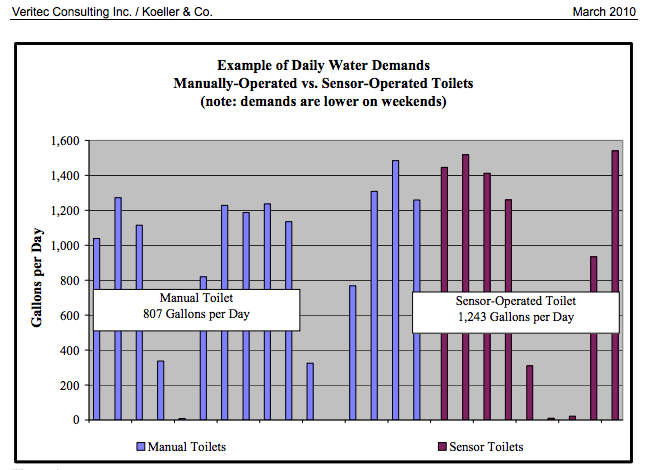Why You Should Rethink Using an Automatic-Flush Toilet

By:
Toilets in public places can be scary.
Although there are many opportunities for gross moments in public bathrooms, toilets with an automatic flush aim to at least keep the toilet bowl clear of leftovers. However, the commitment to keeping the bowl clean could cost us in other ways.
 Flickr/David Amsler - flic.kr
Flickr/David Amsler - flic.kr
We could be paying in water. In a 2010 study on the water efficiency of sensor-operated plumbing fixtures, researchers found that toilets with sensors in a Tampa office building used 54 percent more water than the regular toilets. In a place like the Los Angeles International Airport, where thousands of people pass through the bathrooms, that could mean more than 40 million gallons of water are being wasted every year, according to the Los Angeles Times.
The best we can hope for with sensor-operated toilet fixtures is that they use the same amount of water as regular toilets. Bill Gauley, one of the authors of the study on sensor-operated plumbing fixtures, told ATTN: that it's not likely automatic-flush toilets would ever be more water efficient than manual ones.
"Because it is not possible to have a phantom flush with a manual valve, there is no way for a sensor valve to be more efficient than a manual valve of the same flush volume," Gauley said. "The best it can be is equally efficient." (A "phantom flush" is when the automatic toilet flushes when it doesn't need to, usually because of movement.)
Gauley, along with his research partner John Koeller, found that in one day, the manual toilets in the Tampa office building used 807 gallons of water, but the sensor-operated toilets used 1,243 gallons.
 Veritec Consulting Inc. / Koeller & Co. - map-testing.com
Veritec Consulting Inc. / Koeller & Co. - map-testing.com
The study authors wrote that although their test was relatively small, it shows a big increase in water use.
"While the results achieved in this relatively small-scale project may not necessarily be indicative of results that might be achieved in other projects, they clearly indicate a significant increase in water demands when manually operated plumbing fixtures on the seventh floor were converted to sensor-operated models," Gauley and Koeller wrote in the study.
However, Gauley said that the technology in 2016 is better than it was in 2010.
"Sensor-operated flush valve technology is getting better and there seems to be fewer instances of phantom flushes and 'missed' flushes now than five or 10 years ago," Gauley said.
But small instances of extra water use add up to large amounts.
"People should be aware that all the little water uses each day can really add up," Gauley said. "The average American uses about 55 to 65 gallons of water each day in their home. That is a lot of water!"
This is important in places that are experiencing severe droughts, such as California. About 66 million trees have died in California's Sierra Mountains since 2010, according to ABC News. Counterintuitive is that the state lifted its water restrictions earlier this year, despite Lake Mead, one of California's largest reservoirs, reaching its lowest point since 1937.
Gauley hopes that people will take water conservation seriously and try to save water in their daily life.
"An efficient person can use less than 40 gallons per day ... If everyone in California became efficient, think how many millions and millions of gallons of water could be saved each day."
